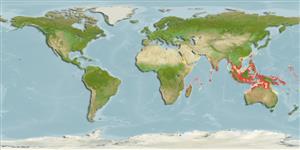>
Batrachoidiformes (Toadfishes) >
Batrachoididae (Toadfishes) > Halophryninae
Etymology: Allenbatrachus: Composed from Jerry Allen an Australian taxonomist + Greek, batrachos = frog (Ref. 45335).
More on author: Linnaeus.
Environment: milieu / climate zone / depth range / distribution range
Ökologie
seewasser; brackwasser demersal; pH range: 7.8 - 8.5; amphidrom (Ref. 51243). Tropical; 23°C - 28°C (Ref. 2059)
Indo-West Pacific. Recorded from the Persian Gulf (Ref. 80050). Known from the Mekong delta (Ref. 12693).
Size / Gewicht / Alter
Maturity: Lm ? range ? - ? cm
Max length : 30.0 cm TL Männchen/unbestimmt; (Ref. 4833)
Rückenflossenstacheln (insgesamt) : 3; Rückenflossenweichstrahlen (insgesamt) : 18 - 22; Afterflossenweichstrahlen: 16 - 17; Wirbelzahl: 26 - 27.
Occurs in bottom areas mainly in the coastal waters. Euryhaline (Ref. 12041). Found in the sea and estuarine areas (Ref. 4833). Occurs in estuaries over muddy bottoms (Ref. 12693).
Life cycle and mating behavior
Maturities | Fortpflanzung | Spawnings | Egg(s) | Fecundities | Larven
Greenfield, D.W., 1997. Allenbatrachus, a new genus of Indo-Pacific toadfish (Batrachoididae). Pac. Sci. 51(3):306-313. (Ref. 26916)
IUCN Rote Liste Status (Ref. 130435)
Nutzung durch Menschen
Fischereien: nicht kommerziell
Tools
Zusatzinformationen
Download XML
Internet Quellen
Estimates based on models
Preferred temperature (Ref.
123201): 26.4 - 29.1, mean 28.3 °C (based on 1238 cells).
Phylogenetic diversity index (Ref.
82804): PD
50 = 0.6250 [Uniqueness, from 0.5 = low to 2.0 = high].
Bayesian length-weight: a=0.00389 (0.00180 - 0.00842), b=3.12 (2.94 - 3.30), in cm total length, based on all LWR estimates for this body shape (Ref.
93245).
Trophic level (Ref.
69278): 3.5 ±0.5 se; based on size and trophs of closest relatives
Widerstandsfähigkeit (Ref.
120179): mittel, Verdopplung der Population dauert 1,4 - 4,4 Jahre. (Preliminary K or Fecundity.).
Fishing Vulnerability (Ref.
59153): Low vulnerability (20 of 100).
